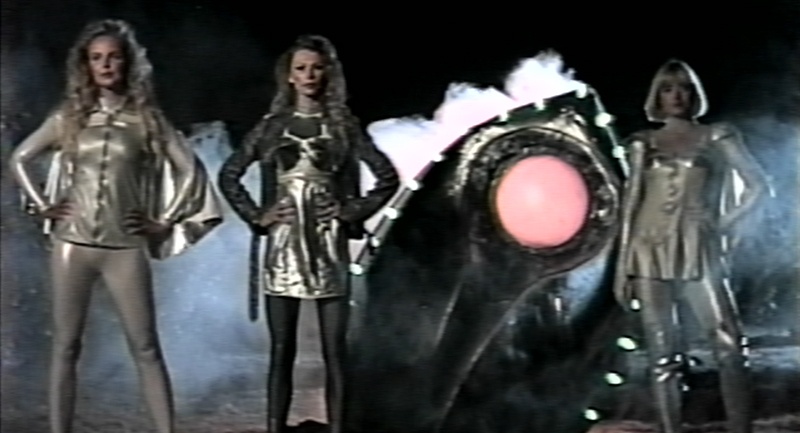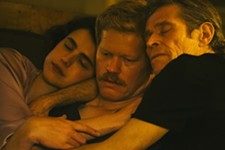Fantastic Fest Interview: Playing With the Tracking With Tim Robbins on VHYes
It's a father-son deal in this home movie insanity
By Richard Whittaker, 1:48PM, Thu. Sep. 19, 2019
You're never too old to be a supportive parent. Just ask Tim Robbins, who not only appears in his son Jack Henry Robbins' latest brainmelting creation, VHYes, but is also its executive producer.
The star of Bob Roberts, Jacob's Ladder, The Shawshank Redemption, and – more recently – Castle Rock and Here and Now, Robbins described his son's elevator pitch simply: "'What if you're going through an old box, and you find a videotape, and you put it in?'"
What the younger Robbins was proposing (and had already started writing) was a surreal take on found footage: in 1987, a young boy is given a video camera, and starts recording on the first tape to hand – not realizing that it was actually his parents' wedding video. Then he works out how to record from TV, and the world opens up. Robbins said, "It created this beautiful open canvas, and his and [co-creator Nunzio Randazzo]'s imaginations could go wild."
For Tim Robbins, the effect of watching an old tape is somewhat dreamlike. "You're viewing something, an experience you had, that you remember you were there, and you're shooting it, but it doesn't look like I remember it quite. Sometimes I'm watching stuff, and I'm not even sure I was there."
Jack Henry had already experimented with the form with two shot-on-video shorts that had already made it to Sundance: "Painting With Joan," a spoof of the old PBS educational show hosts like Bob Ross and Nancy Zieman, and "Hot Winter: A Film by Dick Pierre," a 1970s SF porno with all the porn cut out. Both are woven into VHYes, as if the young boy is flicking through the channels, and this is a world where those shows are real. And Jack Henry was going to shoot this all on a period VHS camera.
"There was something about the form that he loved," said Tim Robbins. "Given all the great cameras that we have right now that are so accessible, like the Red, he said, 'I want to shoot on a video camera from 1980.' I just loved his inventiveness and courage with that." Naturally, he signed on to his son's project as one of the multitude of characters that pop in and out of their own stories, and the developing meta-narrative, as well as becoming an executive producer. "Every time I've done something with Jack he's really risen to the occasion and made me proud, created a beautiful piece of art."
Yet shooting on VHS isn't as easy as picking up a camera and going and shooting. This is a dead technology: No one makes tapes or recorders or cameras anymore, so everything had to be hunted down. Every tape had to be tested, to make sure it hadn't been demagnetized, before it could be used. Then the sound had to be separately recorded, because VHS sound was notoriously tinny. Then it was archiving time. "I remember at the end of every shoot day, we would take that tape and it was like gold. You have to transfer this cassette onto digital right away. It was our dailies."
Fortunately, the defunct technology gods were smiling on their weird endeavor. They had six cameras on set, and most of the shooting was done with one particular unit that proved completely dependable. "It was a beast," said Tim Robbins. "It was like, 'Wait a second. I have been taken out of a trash bin or an old junk shop. Someone recognizes that I am essential, and I'm going to make the best of it.' It had one last moment in the sun."
Filming was tough, but the really tricky part, Tim said, "was that you could edit it 5 million ways. There's a beginning, a middle and an end for the kid and that story, but everything else? Anything can go anywhere." Finding a structure that was more than just a series of clips "became this really interesting puzzle that had to be solved, and you'd get really close and realize, 'Nah, there's some piece that's not really there yet.'" He compared the process to editing a documentary: "You have so much footage and so many places it could go."
It wasn't going to be able to depend on the conventions of narrative, "where you pretty much know where everything is going to go," said Tim. "You're not going to put the conflict scene in the first act." Without those structures, he said, "It's a matter of feeling. How do I feel after this thing, and how does it flow and cut into this next thing? Or would it be better to put something else there?"
The end of the long process is a film that Tim Robbins calls "a beautiful combination of the deeply silly and absurdly funny, crazy stuff, and this deep, soulful longing." That emotional core is something Tim credits to Henry Jack, and that's where his real pride in his son clearly shines. Even at the age of 3, Tim said, "He was the kind of kid that, when you're working down the street and there's a homeless guy, we would normally – if we had the time – we would stop and get him something to eat, get him a sandwich or something. I remember walking down the street with Jack and we were running late for something, and this homeless guy asked for money. I kept going and Jack, he stopped me. He went, 'Dad, why don't we get him something to eat?' 'Well, we're late.' 'What's more important, that I get to my appointment on time or that he gets something to eat?' And this was a little boy. So he has this deep, beautiful heart, and that finds its way into his work."
VHYes with livestream Q&A with the filmmakers, plus Tim Robbins, Thomas Lennon, Kerri Kenney, John Gemberling, and more. Alamo South Lamar, 1120 S. Lamar. Sun. Jan. 12, 8pm.
Tickets and info at www.drafthouse.com.
A note to readers: Bold and uncensored, The Austin Chronicle has been Austin’s independent news source for over 40 years, expressing the community’s political and environmental concerns and supporting its active cultural scene. Now more than ever, we need your support to continue supplying Austin with independent, free press. If real news is important to you, please consider making a donation of $5, $10 or whatever you can afford, to help keep our journalism on stands.
June 27, 2024
June 28, 2024
Fantastic Fest, Fantastic Fest 2019, VHYES, Tim Robbins, Jack Henry Robbins









